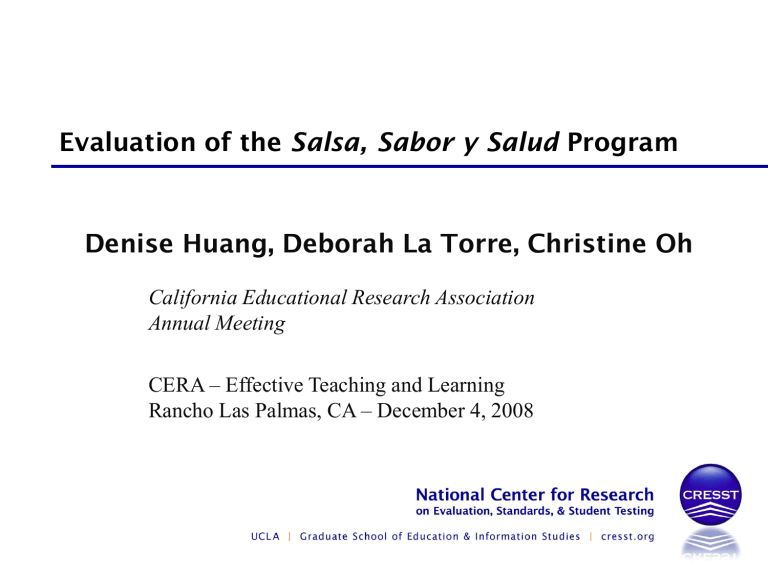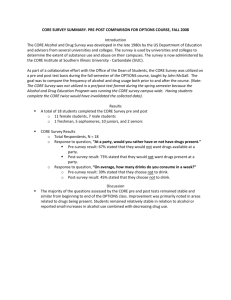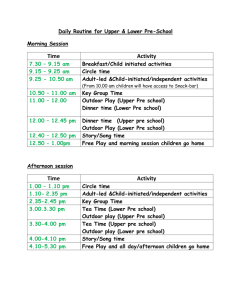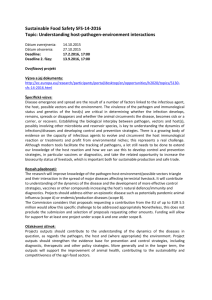Physical Activity

Evaluation of the Salsa, Sabor y Salud Program
Denise Huang, Deborah La Torre, Christine Oh
California Educational Research Association
Annual Meeting
CERA – Effective Teaching and Learning
Rancho Las Palmas, CA – December 4, 2008
The Problem
• There is an alarming trend towards obesity and inactivity among children
• The center for Disease control and Prevention predicted that one in 3 children born in 2000 would become diabetic
• Minority and economically disadvantaged children are especially at risk
• One in two Latino children will become diabetic
2 / 27
The Intervention
• Kraft Foods has partnered with the National Latino
Children’s Insitute and developed a healthy lifestyle educational program for Latino families
• Salsa Sabor y Salud (Food, Fun, & Fitness)
Improve the awareness of habits leading to better nutrition and increased physical activities
Family oriented
Culturally relevant
3 / 27
Early Evaluation
• Positive changes over time were found
• These positive results suggest that the immediate outcomes the program seeks to achieve are attainable
• The program has begun to transform the lives of those for which is intended.
4 / 27
Adaptation of the SSS program
Piloting programs:
Chicago- 2 programs
Association House
Centro Communitario Juan Diego
(CCJD)
Los Angeles- LA’s BEST
5 / 27
Purpose of the Study
• To conduct a process evaluation to describe how functional the SSS curriculum is after the adaptation from family-centered to studentcentered
• To conduct an outcome evaluation in order to examine the effectiveness of the SSS program in influencing students’ knowledge, attitudes, and behaviors regarding a healthy lifestyle.
6 / 27
Research Questions
• How well has the program been adapted for use in a child-focused setting?
• What adaptations “worked?”
• What adaptations did not “work?”
• Is the program being delivered as planned?
• Whether/how are the staff and students engaged in the program functioning?
• What impact has the program had on student and program staff participants?
• What is the reach of the program, as implemented with children only?
7 / 27
The Chicago Programs
• CCJD was established in the 1990s by 8 Latino community members
• Its mission is to promote leadership and social change while serving those in need
• It provides the community with programs focused on social services, health care, education, and community organizing.
• In 2007, CCJD employed over 70 staff members
8 / 27
The Association House
• The Association House is established in 1899 to serve as a resource to provide services that meet community needs.
• Its core mission is to offer services to economically disadvantaged individuals and families
• Its services include behavioral health, child welfare, and community services
9 / 27
Program fidelity
• Context
training
resources
• Compliance
Lessons delivered as planned
Lessons delivered effectively
• Competence
Staff efficacy
Staff perceived value of the program
10 / 27
Context-Training
• Both of the 2 staff members in CCJD responsible for the SSS curriculum received training and reported having experience in conducting the original version of the SSS curriculum
• The staff at the association House did not received first hand training but were able to obtain assistance from other experienced staff
11 / 27
Context-Resources
• At CCJD- Conflicting opinions between the site coordinator and assistant coordinator
Space
Limited economic resources for fresh foods
• At association House
More training
More staff
12 / 27
Compliance-Lesson delivered as planned
• Both organizations appeared to follow the structure of the lesson plans of the SSS curriculum
• Both mentioned students enjoyed the hands-on games, music activities, but sometime appeared bored during the lectures
13 / 27
Compliance-Lesson delivered effectively
• Staff at both programs were able to use a variety of teaching strategies to engage students including cross-content integration and real-world connections
Students at both programs displayed high levels of engagement, participating in discussions, demonstrating anticipation and excitement in learning about the origins of food
14 / 27
Competency-Staff Efficacy
• Staff at both programs demonstrated high efficacy concerning their ability to implement the SSS curriculum
• These staff found ways to adapt their practices to keep students interested and engaged
• Students felt both physically and emotionally secured with the staff and were positiely supported by the staff during their participation
15 / 27
Competency- Value of the Program
• All staff felt the program is important
• They were happy to be a role model concerning healthy lifestyles
• The staff were satisfied with the program and believed the students were as well
16 / 27
Evidence of Impact-students
• Students at both organizations talked exclusively about increased knowledge and improved behavior
• The program coordinator at Association House of
Chicago indicated that the students benefited in terms of attitudes and knowledge
• The staff at CCJD focused on gains in knowledge and behavior
17 / 27
Evidence of impact-staff
• The staff members noted positive impact on their own lives as well as the lives of their families
• Their comments mostly focused on knowledge and behavior
18 / 27
Evidence of Impact-reach
• Some of the students at both Association House of
Chicago and CCJD reported talking with their parents about the program
19 / 27
Summary
Judy Nee (2006), president and CEO of the National After-School
Association stated 5 important practices in preventing obesity:
Purposeful and intentional curriculum and activities development
Integration of nutrition and physical activity focusing on the whole child
Provide meaningful experiences that integrate nutrition and physical activity
Provide nutritional knowledge and model with healthy snacks
Be health-centered rather than weight-centered and maintain cultural sensitivity
20 / 27
Students were able to connect healthy eating and physical activities with :
A healthy body
Less frequency of illness
Increased concentration in school
21 / 27
Defining Culturally Relevant
Teaching
“A pedagogy that empowers students intellectually, socially, emotionally, and politically by using cultural referents to impart knowledge, skills, and attitudes.”
Gloria Ladson-Billings, 1994, p. 17-18
22 / 27
Session Themes
• Family Reunions
• The Perfect Pair
• Mid-day Snacks
• Seeds of the
Americas
• The Harvest
• Salsa y Sabor
• At the Park
• The Celebration
23 / 27
Culturally Relevant Practices for
Latino Children
• Foster community
(Nieto & Rolon, 1997; Sanchez et al., 1992)
• Build on students history, culture, and language
(Cummins, 1989; Gloria Ladson-Billings, 1994)
• Active learning and experiential learning
(Ortega et al, 1993; Shannon, 1995)
24 / 27
Five-Step Lesson Plans
Each session, except the first, included:
1.
An introduction
2.
A review of past concepts
3.
One or more hands-on nutrition activities
4.
At least one physical activity
5.
A discussion of the activities and what was learned during the session
25 / 27
Teaching Strategies
• Staff used a variety of teaching strategies
• Staff reported using the teaching strategies recommended in the curriculum guides and at the trainings
• Student engagement varied at the sites
26 / 27
Cultural Capital Theory (Bourdieu & Passeron,
1977)
Cultural capital refers to the accumulation of cultural knowledge, skills and abilities possessed and inherited by privileged groups in society
(e.g., access and knowledge about the education system and how to navigate through school)
Can be acquired from one’s family and schooling
The dominant groups within society are able to maintain power because access is limited to acquiring and learning strategies to use these forms of capital for social mobility
27 / 27
Critical Race Theory (Matsuda, 1991; Delgado-
Gaitan,
2001; Delgado Bernal, 2002)
Shifts the center focus from notions of White, middle class culture to the cultures of
Communities of Color; addresses the social construct of race by examining the ideology of racism and how that plays a part in educational institutions
“…the work of progressive legal scholars of color who are attempting to develop a
28 / 27 jurisprudence that accounts for the role of racism in American law and that work toward
Community Cultural Wealth Model (Yosso, 2005)
Shifts away from a deficit view of Communities of Color as places full of cultural poverty disadvantages, and instead focuses on marginalized groups that often go unrecognized and unacknowledged (Yosso, 2005)
various forms of capital other than traditional forms of capital
draws upon the “knowledges” of Students of Color, and what they bring with them from their homes and communities into the classroom (e.g., sense of collectivity, willingness to do community outreach, a high sense of responsibility to integrate the community, leadership skills, etc.)
29 / 27
Adaptation of “Salsa Y Salud” Program
background: n= 20 sites; over 90% of the sites adapted the lessons from the original curriculum
I.
Reasons for Adaptation
** A. to moderate the content so that it was culturally appropriate for Latino students as well as non-Latino students participating in program
B. to maintain the interest of their students
C. ensure that the activities were age-appropriate
30 / 27
A. Cultural Appropriateness
“…Sabor y Salud has things that they can really relate to since they are mostly Hispanic, so they have a lot of things in there like family gatherings and all of that, I think it’s more helpful for them…they remember all of the memories they have going to their family gatherings, and the food they eat.”
31 / 27
Ways to keep the Program More Culturally-
Relevant
-integrate Spanish music w/ activities
-discuss Spanish foods (e.g., frijoles, beans, salsa, etc.)
-brought about a collectivity when doing activities relates back to
Latino family and “together-ness”
** helping non-Latino students find significance within the program the
B. Keeping the Interest of Students
“ I think the way I chose how to have the children adapt to it was to have it be a little bit more fun, not so by the book (SSS curriculum). I definitely use the book, but some of the things you read and then do it your own way. That’s how I decided to do it with the children because I think if I went by the book they’d find it boring. For them, their attention span is not so great. I’ve got to catch them quick or
I’ll lose them…that was my thing.”
33 / 27
C. Age-appropriateness
“We don’t always go with the book (SSS curriculum)…it doesn’t give us specific facts on how to break down the nutrition factor…the book doesn’t teach us how to explain it to them (the students)…When I start the entire activity I start with questions.
‘How many of you know what this means? How many of you know what lard is?’ From there I move on. If the questions are too high
(difficult), if I’m going to be asking the first grader who knows what lard is, some of them have no clue. So, that’s when I start breaking it down. I go from there and from whatever they know.”
34 / 27
II. Maintaining Program Fidelity on Adaptations
“With my co-workers [other SSS program staff] they like some of the things I’m doing. I ask them to let me know how they did so maybe later on they could do something close to what I’m doing with their students to see if they like it. If their students like it they might like adding it to their class.”
35 / 27
III. What Works With the Students?
A.
Content
Student 1: My favorite activity in Salsa, Sabor y Salud was when we made an apple with peanut butter and pretzel sticks with raisins and granola. We [make] healthy fruits and it was fun and nutritious.
Student 2: Like he sad, we made an apple. It was fun to make it.
[SSS program staff member] said it was good for you. And we wrote the recipe for it so we could make it at home.
36 / 27
B. Physical Activities
Student 1: I liked when we went to the obstacle course, because we were racing against each other. And it was fun, because we actually had to get in the cones and out of the cones, and we had to jump the hula hool, and we had to jump fives times.
Student 2: That when, when we were going to do the, the second obstacle course I could see where it was. So I knew that it was going to be fun, because I saw a lot of cones there.
37 / 27
V. What Does not Work? Why do Students Feel
Uncomfortable?
-boredom from the lack of variability in activities (e.g., doing the same activities over and over again)
-lack of variety in the SSS program location (e.g., constantly doing activities only within the classroom; not going outside as much)
38 / 27
Curriculum Emphasized Four Key
Messages
1.
Eat foods from each of the food groups every day
2.
Be sensible about portion size
3.
Be physically active every day
4.
Take small steps for success
39 / 27
Healthy Behavior Outcomes
• Surveys were administered:
Pre and Post
Program students and matched control students
• Areas assessed:
Knowledge and Awareness
Attitudes
Unhealthy Behaviors
Healthy Behaviors
40 / 27
Knowledge and Awareness
• Healthy snacks
• The benefits of being active
• General guidelines for healthy nutrition
• What constitutes healthy activity
41 / 27
Healthy Snacks
A handful of grapes
An apple
A glass of milk
A bag of chips
An order of French fries
A piece of carrot cake
A glass of orange soda
Matched control sample ( n = 384)
Pre survey
88.8%
88.3%
89.0%
8.1%
10.7%
32.9%
85.4%
Post survey
88.8%
86.7%
87.0%
14.3%
14.3%
40.6%
88.8%
Program sample ( n = 384)
Pre survey
89.8%
91.1%
91.1%
8.3%
9.1%
34.1%
88.5%
Post survey
88.5%
89.1%
85.7%
13.5%
14.6%
39.1%
83.6%
42 / 27
The Benefits of Being Active
It helps keep you from getting sick.
It helps you pay attention in school.
Matched control sample ( n = 384)
Pre survey Post survey
37.6% 42.9%
44.9% 50.0%
It gives you more energy.
It helps build healthy bones and muscles to keep you strong.
It helps me to be a healthy weight.
80.9%
84.3%
77.0%
81.7%
88.0%
79.3%
Program sample ( n = 384)
Pre survey Post survey
52.9% 52.1%
47.7%
86.7%
54.7%
84.1%
88.3%
75.3%
87.0%
79.7%
43 / 27
General Guidelines for Healthy
Nutrition
Fruits and vegetables.
The same food every day.
Different foods from all the food groups.
6 glasses or more of water a day.
A lot so that my stomach feels extra full.
Matched control sample ( n = 384)
Pre survey
90.1%
Post survey
89.8%
37.6%
76.2%
82.8%
18.3%
33.3%
78.6%
79.7%
23.7%
Program sample ( n = 384)
Pre survey
94.5%
Post survey
91.1%
34.8% 24.7%
82.2%
85.6%
18.3%
83.3%
83.3%
19.5%
44 / 27
What Constitutes Healthy Activity
Jump rope
Play sports
Dance
Ride a bicycle
Play videogames
Watch TV
Play board games
Matched control sample ( n = 384)
Pre survey
78.9%
85.9%
68.9%
81.5%
16.2%
11.7%
20.4%
Post survey
81.7%
87.2%
67.9%
83.8%
19.3%
18.0%
19.3%
Program sample ( n = 384)
Pre survey
83.8%
89.0%
72.6%
86.7%
15.7%
11.5%
21.7%
Post survey
86.2%
87.2%
77.1%
87.8%
19.3%
18.7%
24.7%
45 / 27
Program Effects on Student
Knowledge
Grade level
Primary grades (1-2)
Upper grades (3-5)
Total by sample
Matched control sample ( n = 384)
0.01
-0.04
-0.02
Program sample ( n = 384)
-0.19
0.13
-0.03
Total by grade level
-0.09
0.04
46 / 27
Program Effects on Student
Attitudes
Grade level
Primary grades (1-2)
Upper grades (3-5)
Total by sample
Matched control sample (n = 384)
-0.02
-0.04
-0.03
Program sample (n = 384)
0
0.05
0.03
Total by grade level
-0.01
0.01
47 / 27
Attitudes
• Healthy food and junk food
• The taste of healthy food and junk food
• The ability to make healthy nutrition choices
• Physical activity
48 / 27
Healthy Food and Junk Food
Program sample ( n = 384)
Pre survey Post survey
Eating healthy foods makes me feel ____.
terrible good sad tired
Eating junk food makes me feel _____.
terrible good sad tired
Matched control sample ( n = 384)
Pre survey Post survey
8.3%
89.6%
3.1%
2.9%
42.7%
29.7%
11.5%
28.9%
8.1%
86.7%
1.6%
4.7%
42.2%
31.8%
8.6%
28.6%
49 / 27
5.7%
90.4%
2.6%
7.8%
41.7%
34.6%
6.8%
29.7%
3.4%
90.4%
3.4%
6.3%
44.0%
28.6%
10.9%
32.0%
Taste of Healthy Food and Junk
Food
Program sample ( n = 384)
Pre survey Post survey
Healthy food tastes
____.
gross better than junk food terrible
Good
Junk food tastes ____.
gross better than healthy food terrible good
Matched control sample ( n = 384)
Pre survey Post survey
7.3%
43.2%
5.5%
56.5%
28.9%
12.5%
29.9%
39.3%
8.6%
43.0%
4.9%
56.2%
32.6%
15.6%
25.8%
37.2%
5.5%
41.1%
4.7%
61.5%
27.6%
14.3%
29.4%
41.4%
7.0%
43.5%
7.6%
56.3%
29.9%
13.8%
31.3%
38.3%
50 / 27
Ability to Make Healthy Food
Choices
Program sample ( n = 384)
Pre survey Post survey
It is ____ for me to select healthy choices when I eat.
hard boring easy fun
Matched control sample ( n = 384)
Pre survey Post survey
23.7%
7.3%
39.8%
41.9%
22.9%
9.1%
38.0%
43.0%
32.0%
8.1%
34.9%
39.8%
28.4%
8.9%
39.3%
38.3%
51 / 27
Physical Activity
Being active is ___.
hard boring easy fun
Being active makes me feel ___.
tired energized terrible good
Matched control sample ( n = 384)
Pre survey Post survey
12.0%
6.0%
28.9%
71.6%
13.3%
46.9%
4.9%
54.7%
9.6%
6.8%
34.1%
66.1%
14.1%
46.9%
4.2%
56.2%
52 / 27
Program sample ( n = 384)
Pre survey Post survey
10.2%
6.3%
31.8%
67.7%
10.7%
6.0%
31.5%
70.8%
15.6%
40.1%
4.9%
58.1%
14.8%
45.6%
5.2%
56.0%
Unhealthy Student Behavior
• Intake of sweets and junk food
• Intake of caloric proteins
• Intake of less healthy fluids
• Sedentary behaviors
53 / 27
Intake of Sweets and Junk Foods
ice cream flan cookies
French fries potato chips pan dulce/sweetbread
Matched control sample ( n = 384)
Pre survey Post survey
2.84
1.95
2.73
2.6
2.32
2.37
2.76
1.96
2.63
2.43
2.39
2.27
Program sample ( n = 384)
Pre survey Post survey
2.71
2.05
2.65
2.44
2.33
2.23
2.63
2.02
2.55
2.34
2.26
2.19
54 / 27
Intake of Caloric Proteins
ham cheese enchiladas pizza tacos hamburgers
Matched control sample ( n = 384)
Pre survey Post survey
2.38
2.45
2.42
2.81
2.71
2.58
2.29
2.41
2.35
2.79
2.53
2.54
Program sample ( n = 384)
Pre survey Post survey
2.57
2.46
2.42
2.75
2.69
2.53
2.45
2.47
2.32
2.56
2.53
2.39
55 / 27
Intake of Less Healthy Fluids
soda lemonade chocolate milk
Matched control sample ( n = 384)
Pre survey Post survey
2.57
2.87
2.9
2.56
2.74
2.79
Program sample ( n = 384)
Pre survey Post survey
2.43
2.84
2.71
2.33
2.73
2.66
56 / 27
Sedentary Activity
watch TV play video games
Matched control sample ( n = 384)
Pre survey Post survey
3.17
2.51
3.19
2.50
Program sample ( n = 384)
Pre survey Post survey
3.21
2.59
3.03
2.45
57 / 27
Program Effects on Unhealthy
Student Behaviors
Grade level
Primary grades (1-2)
Upper grades (3-5)
Total by sample
Matched control sample (n = 384) Program sample (n = 384) Total by grade level
-0.08
0.12
0.02
0.03
-0.09
-0.03
-0.02
0.01
58 / 27
Healthy Student Behavior
• Intake of fruits and vegetables
• Intake of healthy proteins
• Intake of healthy fluids
• Physical activity
59 / 27
Intake of Fruits and Vegetables
broccoli apples carrots grapes corn oranges
Matched control sample ( n = 384)
Pre survey Post survey
2.50
3.25
2.82
3.19
2.66
3.14
2.39
3.17
2.6
3.09
2.59
3.08
Program sample ( n = 384)
Pre survey Post survey
2.53
3.19
2.83
3.22
2.67
3.17
2.53
3.14
2.78
3.19
2.58
3.16
60 / 27
Intake of Healthy Proteins
chicken nuts beans turkey peanut butter yogurt
Matched control sample ( n = 384)
Pre survey Post survey
2.78
2.05
2.52
2.30
2.41
2.92
2.68
1.91
2.41
2.12
2.24
2.79
Program sample ( n = 384)
Pre survey Post survey
2.83
2.02
2.57
2.25
2.38
2.80
2.71
1.97
2.62
2.22
2.46
2.87
61 / 27
Intake of Healthy Fluids
juice water milk
Matched control sample ( n = 384)
Pre survey Post survey
3.26
3.66
3.36
3.27
3.61
3.16
Program sample ( n = 384)
Pre survey Post survey
3.24
3.59
3.31
3.14
3.54
3.24
62 / 27
Physical Activity
jump rope play sports dance ride a bicycle
Matched control sample ( n = 384)
Pre survey Post survey
2.78
3.40
2.53
2.93
2.72
3.34
2.57
2.82
Program sample ( n = 384)
Pre survey Post survey
2.74
3.33
2.55
2.85
2.78
3.29
2.57
2.82
63 / 27
Program Effects on Healthy
Student Behaviors
Grade level
Primary grades (1-2)
Upper grades (3-5)
Total by sample
Matched control sample (n = 384) Program sample (n = 384) Total by grade level
-0.20
0.02
-0.09
0.22
-0.02
0.10
0.01
0.00
64 / 27
baker@cse.ucla.edu





